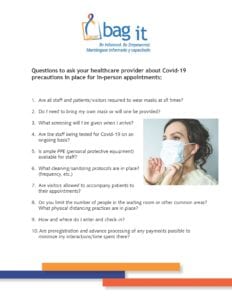 Raise your hand if you postponed or converted to telemedicine visits for “nonessential,” routine and/or preventive healthcare early in the Covid 19 pandemic. If yes, many of us did the same thing.
Raise your hand if you postponed or converted to telemedicine visits for “nonessential,” routine and/or preventive healthcare early in the Covid 19 pandemic. If yes, many of us did the same thing.
As stay-at-home restrictions lifted, many providers started seeing more patients in person while still offering a virtual option. But there can be confusion around which appointments we should now schedule to see the doctor in person.
Simple blood tests, urine tests and direct exams can detect early cancers, diabetes, hypertension and many other illnesses. Some critical aspects of care, like a physical exam, can only be performed in the office. Another question is whether it is safe to schedule overdue or upcoming screening tests and other procedures – especially as the pandemic continues to rise in many communities.
These are shared decisions between you and your healthcare provider. Keep in mind that your provider wants you to be in touch and wants you to get the medical care that you need. Call your doctor’s office to discuss your particular healthcare situation. Speak candidly about any concerns and questions you have, as well as making clear your needs and preferences. Together you can assess what’s best for you and make a game plan for your care.
If you’ll be scheduling an appointment for an in-person visit you will probably be asked if you are experiencing any Covid-related symptoms and if anyone in your home has tested positive for Covid-19.
 Healthcare providers receive guidelines from state, local, county health departments and the CDC about how to safely operate their facility while minimizing risk to patients and their staffs. Many providers have implemented scheduling, staffing and technology tools to complement the physical distancing procedures and environmental changes they have made. If you are not automatically provided with the pertinent detail when you schedule your appointment, click here for some questions to ask the scheduler about the practices in place. You can also check out the provider’s website for information posted there about steps they are taking.
Healthcare providers receive guidelines from state, local, county health departments and the CDC about how to safely operate their facility while minimizing risk to patients and their staffs. Many providers have implemented scheduling, staffing and technology tools to complement the physical distancing procedures and environmental changes they have made. If you are not automatically provided with the pertinent detail when you schedule your appointment, click here for some questions to ask the scheduler about the practices in place. You can also check out the provider’s website for information posted there about steps they are taking.
For more tips on how to safely navigate an in-person medical appointment, read below
- If you are experiencing Covid-related symptoms the day of your in-person appointment, call the provider’s office for guidance before you go in.
- When you arrive to the facility, you will likely find new procedures and safety precautions put in place since your last visit. Follow the requested instructions and communicate with the staff if you observe something or are asked to do something that makes you feel uncomfortable.
- Wear a mask or face covering throughout your visit unless you need to remove it for a procedure or are requested to do so by your provider.
- Wash your hands with soap and water for at least 20 seconds or use hand sanitizer with 60% alcohol before and after touching any surfaces in waiting areas, exam rooms, and other common areas. Avoid touching surfaces as much as possible.
- Avoid touching your face, including your eyes, nose and mouth.
- Cover your cough or sneeze with a tissue or your elbow, and throw away the tissue. When wearing a mask, cough or sneeze into the mask.
- Follow social distancing recommendations as much as possible.


Recent Comments